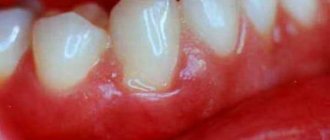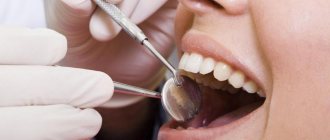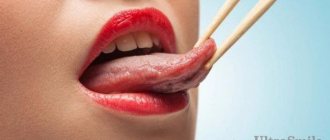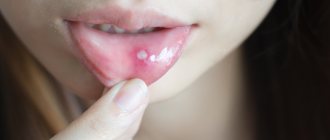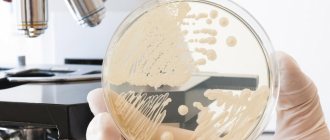Saliva is a fluid in the body that performs important functions. After food enters the oral cavity, the process of digesting food begins with the help of enzymes found in saliva. It also moistens food to make it easier to swallow and taste the food. Saliva neutralizes alkali and acid, and also protects against various microbes.
Quite often, people turn to medical institutions asking why there is blood in their saliva. If everything is normal in the body, then there should be no blood. If it is, then it is necessary to find out the reasons and determine the correct treatment. It is important to understand that saliva with blood can be both a safe phenomenon and a sign of a dangerous pathology.
Bloody discharge can be classified according to daily volume: true hemoptysis (no more than 50 ml), light bleeding (no more than 100 ml), moderate (up to 500 ml), heavy (up to 1000 ml).
Why does blood appear on teeth and how to deal with the problem
Bleeding gums are an alarming symptom that does not occur on its own, but is a sign of poor oral health. The problem cannot be left to chance. To find out the reasons for its appearance, you need to consult a dentist: if your gums are bleeding, this may indicate the development of a serious oral disease or an infection. In addition, the lack of timely treatment contributes to the appearance of bad breath, which will reduce the quality of life and lead to the development of complexes.
Diagnostics
The examination is usually initiated by therapists. They collect anamnesis, clarify the relationship of bleeding with the time of occurrence, provoking factors, and the amount of blood loss (frequency, volume of vomiting). If complaints are associated with hemoptysis, vomiting of scarlet foamy liquid, then the person is referred to pulmonologists. When vomiting dark blood or coffee grounds, gastroenterologists are involved in diagnosis and treatment. If there is no vomiting or cough, and blood is released only with saliva, dentists and otolaryngologists are more often involved in identifying the cause.
When examining, pay attention to the color of the skin; in case of chronic and severe blood loss, they are pale in color. Hemorrhages and hematomas may indicate blood diseases and coagulation system disorders. Jaundice coloration can cause liver diseases and dilated veins of the esophagus.
The main laboratory indicators are the level of red blood cells, hemoglobin, and platelets. As well as coagulogram data, the amount of urea, bilirubin, creatinine, ALT, AST. If tuberculosis is suspected, sputum is examined. Depending on the suspected source of bleeding, the following instrumental studies may be required:
- radiography of the lungs, stomach, esophagus;
- Ultrasound of the abdominal organs;
- angiography of mesenteric vessels;
- rhinoscopy;
- CT and MRI of the lungs;
- bronchography;
- irrigoscopy;
- colonoscopy;
- FGDS with and without biopsy.
In addition, bronchial arteriography, angiopulmonography, and radioisotope studies may be required.
Important! If a vitamin deficiency is suspected, a blood test is prescribed to determine the level of vitamin C and K.
Causal factors for bleeding
Normally, the gums are pink, smooth, dense, and fit well to the teeth. Any changes, including the appearance of bleeding, should be cause for concern. Various reasons can provoke the occurrence of an undesirable symptom.
Oral diseases
Often the problem begins as a result of bacterial activity. Under favorable conditions, namely insufficient oral hygiene, they actively reproduce. Because of this, a soft plaque forms on the teeth, which calcifies over time. This is how tartar appears. These are already solid deposits that provoke the development of an inflammatory process, which threatens the appearance of the following diseases:
- Gingivitis. When the disease occurs, the marginal part of the gum and interdental papillae become inflamed. In addition to bleeding, redness and swelling are formed in those areas where the mucous membrane comes into contact with dental plaque.
- Periodontitis. The disease manifests itself as a result of untreated gingivitis. In this case, the pathological process moves to periodontal tissues - those that hold the tooth in the socket.
The appearance of gingivitis and periodontitis is possible not only in an adult, but also in a child. According to statistics, tartar occurs in 2/3 of all high school students, and 1/4 of school-age children experience gingivitis.
Other diseases
The cause of bleeding may be vitamin deficiency. It is difficult to determine which vitamins are lacking when it occurs, because an imbalanced diet in general has a bad effect on oral health. But it is worth introducing foods containing iron, vitamin C and potassium into your diet. If you have an unpleasant symptom, you must also exclude the following diseases and pathologies:
- disruption of the gastrointestinal tract and endocrine system;
- blood diseases;
- diabetes;
- AIDS;
- disruption of metabolic processes in the body;
- fragility of blood vessels;
- infectious diseases of the throat and nose;
- allergic reaction to medications, materials used in dentistry, toothpaste.
Bleeding gums are common in pregnant women and teenagers. This is explained by hormonal changes in the body. Expectant mothers often note that their gums hurt and swell. This condition is short-term and goes away on its own.
Common reasons
As already mentioned, blood in the mouth can occur due to poor oral hygiene. Incorrect brushing technique (strong, intense pressure) can lead to injury to the gums. Thus, using a hard toothbrush is a constant traumatic factor. Wisdom teeth are often difficult to clean. Due to problems with access, the brush hurts the gums. Bleeding may also occur for the following reasons:
- wearing braces or dentures;
- malocclusion;
- incorrect dental treatment of teeth or gums;
- smoking - bleeding occurs due to toxins that irritate saliva and weakened immunity in smokers;
- burn and injury to the mucous membrane with a sharp object;
- chipping of an old filling.
Taking certain medications can sometimes cause a decrease in the rate of saliva production. Since it resists bacteria, this can provoke a sharp development of pathogenic microflora.
What it is?
First, you need to understand what bleeding is. So, this is the release of blood from blood vessels as a result of a violation of their integrity. Bleeding can be of two main types:
- Traumatic, that is, those that arise as a result of mechanical damage to body tissues due to external factors (impact, cut).
- Non-traumatic. They arise as a consequence of various diseases or pathological conditions (for example, bleeding can be caused by tumors or chronic diseases).
It should also be noted that the adult body contains about 5 liters of blood. In this case, the loss of already two liters is considered deadly.
Symptoms accompanying gum disease
Pathologies that cause blood from the mouth may be accompanied by a number of other unpleasant symptoms:
- swelling of the gums;
- pain when pressing or eating solid foods (sometimes the pain is quite severe);
- itching and discomfort in the gum tissue;
- bad breath;
- tooth mobility (with advanced dental diseases).
Even if nothing bothers you throughout the day, and blood appears only when brushing your teeth, this may indicate a problem.
Symptoms
Blood is usually present in the mouth in small quantities and is visible in saliva that is reddish in color or has bloody spots or clots. Less common is bleeding, in which there is a lot of blood, it drips or flows out of the mouth and stains the bed linen (this can be determined by marks on the pillow or blanket). The symptom is detected in the morning, because at night a person does not feel it, being in a relaxed state in which the brain is partially turned off and does not receive signals transmitted from the body.
The taste of blood in the mouth in the morning is metallic and slightly salty. In addition to the characteristic taste, other symptoms are observed: pain or discomfort in the oral cavity, an unpleasant sourish or putrid odor, ulcers or wounds on the inside of the cheeks and lips, tongue or tonsils, increased body temperature, white, yellowish or brownish coating, increased salivation.
Interesting fact: the presence of blood does not necessarily appear in the presence of a bright scarlet liquid. When mixed with saliva, the color changes to pinkish. The clotting process darkens the blood: when clotted, it turns dark burgundy or brown. If additional impurities are present (pus, food debris), the color becomes even more unusual.
How to quickly stop bleeding from gums
What to do if you need to quickly stop bleeding from your gums? For this purpose, you can use one of the following methods:
- Rinse your mouth with cold water or mint mouthwash. Decoctions of herbs - chamomile, oak bark, fir, calendula - help reduce the manifestations of unwanted symptoms.
- Apply a cotton swab soaked in chlorhexidine to the bleeding area. You need to press it tightly and wait until the bleeding stops.
- Glue a special protective homeopathic strip. You can buy it at the pharmacy.
No matter how long your gums bleed, you cannot put off a visit to the dentist. The problem will not go away on its own, but will only get worse.
How to eliminate constant bleeding gums
To carry out successful treatment, it is important to find out why the gums are bleeding. You should not self-medicate, since the problem requires an integrated approach, which consists in eliminating the cause and restoring the health of the gums. Only a doctor can tell you how to treat a disease that causes bleeding. Different techniques may be needed.
Professional teeth cleaning
If dental plaque provokes complications in the form of bleeding, it is necessary to thoroughly clean your teeth. This does not mean ordinary hygiene procedures at home, but hardware cleaning in a dental office. The doctor uses ultrasound to crush the tartar, the particles of which are washed out with a mixture of water and air. You need to carry out a hygiene procedure twice a year. Unfortunately, not all patients comply with such recommendations.
Air Flow technology is used to remove soft deposits. In this case, finely dispersed soda is supplied along with water. After the procedure is completed, the teeth are polished, which further prevents the accumulation of plaque.
Such actions are sufficient for diagnosed gingivitis. The doctor will also tell you what to do to restore the mucous membrane. This may include rinsing or taking certain medications. Professional teeth cleaning is used if gingivitis has progressed to periodontitis. But this is only the beginning of treatment. Let's talk about ways to eliminate the disease further. If periodontal pockets have formed, you will need powerful ultrasound devices, such as Vector. In this case, the periodontist should deal with oral hygiene.
Rinse with solutions
Antiseptic treatment of the oral cavity can be carried out in the form of rinses based on the following agents:
- "Furacilina";
- "Rotokana";
- "Miramistina";
- "Chlorhexidine";
- alcohol solution "Chlorophyllipt".
Soda-saline solution also helps. You can add a few drops of iodine to it. It is better to use solutions through an irrigator - this increases their effectiveness. In case of bleeding, you need to use special toothpastes, including Parodontax, Lakalut, Colgate Total Pro. The compositions should not have a bleaching effect.
Drug therapy
To eliminate bleeding gums, the doctor may prescribe ointments and gels. They are applied to the problem area after rinsing the mouth. The following drugs are in demand in dental practice:
- "Metrogil Denta" - has antibacterial and anti-inflammatory properties, often prescribed for stomatitis, after tooth extraction;
- “Asepta” is a propolis-based gel that quickly relieves inflammation;
- "Kamistad" is a drug available in two forms (for children and adults);
- "Elugel" is a strong antiseptic that effectively fights pathogenic environments.
For inflammatory processes, the doctor may prescribe medicinal bandages, antibiotics (in some cases), and a course of vitamins.
Gum curettage
For periodontitis with the formation of deep periodontal pockets, the following surgical techniques are used:
- Closed curettage. To carry out the procedure, the doctor uses a special instrument – a curette. With its help, the doctor cleans the roots of the teeth. The tool penetrates to a depth of 3 mm.
- Open curettage. The technique is used when the deposits are deeper. It involves the following actions: peeling of the gums, cleaning and antibacterial treatment, suturing.
The disease can be cured using an integrated approach. Therefore, it is important to follow all doctor’s recommendations even after the procedure.
Treatment
The choice of treatment method depends on the causative factor (source) of blood loss. All people with massive internal bleeding must be hospitalized in a specialized department (gastroenterology, pulmonology). In case of unstoppable bleeding from the nose, anterior or posterior tamponade, coagulation of blood vessels with laser, or radio waves are performed.
For internal bleeding, hemostatic drugs are administered:
- Aminocaproic acid.
- Etamzilat.
- Vikasol.
- Calcium chloride.
To reduce blood pressure, when it is high, Azamethonium bromide, Trimetaphan camsilate, Hexamethonium benzosulfonate, etc. are prescribed. When hemoglobin and red blood cells fall, transfusion of red blood cells and iron supplements are indicated. When the total volume of circulating fluid decreases, plasma is transfused and plasma-substituting solutions are administered drip-wise: rheopolyglucin, dextran. For gastrointestinal blood loss, antisecretory therapy is carried out.
If conservative therapy is ineffective, instrumental and surgical treatment is resorted to. The first involves endoscopic methods. Bleeding vessels in the stomach are clipped or ligated during gastroduodenoscopy. The source of bleeding in the respiratory system is eliminated using therapeutic bronchoscopy, using local applications with a solution of hydrogen peroxide, ethamsylate, adrenaline, and installing hemostatic sponges. Electrocoagulation is also used.
If the bleeding is massive or it is not stopped by conservative and instrumental methods, they move on to surgical methods (opening the chest or abdominal cavity - laparotomy, thoracotomy), which ensure reliable hemostasis and elimination of the source of blood loss. Palliative methods for pulmonary causes include ligation of damaged vessels, extrapleural filling, and collapse therapy.
With radical methods, all affected, bleeding areas are removed within healthy tissue, that is, this is partial or complete removal of the lung. If the cause is a bleeding stomach ulcer, then it is excised within healthy mucous membranes; in some situations, it may be necessary to remove part of the stomach. If it is resected by 2/3, then an anastomosis is created between the intestine and part of the organ.
Important! If the trachea is blocked by blood clots and asphyxia develops, intubation and artificial ventilation are performed.
Preventive measures
To avoid gum problems, you must follow a number of simple rules:
- Perform high-quality and correct hygiene procedures aimed at oral health. It is necessary to select care products that will not injure the mucous membrane. You should brush your teeth morning and evening. Use dental floss with caution. Instead, you can use an irrigator, which will help effectively remove food debris. Your toothbrush should be changed every three months.
- Balance your diet. The body must receive all the necessary vitamins and minerals. To strengthen teeth and gums, it is important to eat solid plant foods, such as apples and carrots.
- Give up bad habits, in particular smoking. Toothpicks should be used with caution.
- Regularly undergo preventive examinations at the dentist - at least twice a year. This will allow timely detection of oral diseases.
Paying close attention to your oral health will help you maintain a beautiful and healthy smile for many years.

